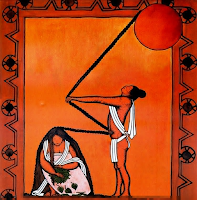In early january we had a couple staying with us, retired French highschool teachers (English and Sports), now living in Corsica. More than twenty years ago, they had lived and worked on Rurutu for seven years. They were back to catch up with old friends and lots of students. Viriamu's sister Dorianne was one of these students, she's always keen for a gossip. Some of her classmates have left, gone to Tahiti or France, but many are still here. They themselves are now parents, teachers, working in the local store, some are even grandparents (yep, generations go fast here!).
It got me thinking about where I was twenty years ago - maybe it's middle age, or all these anniversaries (our wedding anniversary, my 40th looming, 10 years of motherhood, my parents golden coming up), I'm feeling deeply nostalgic these days. Maybe after the 'busyness' of parenthood I now have time to think about where I am, and how I got here (you can take the scientist out of science......).

In January 1997 I was 19, a second year undergraduate, studying Natural Sciences at Girton College, Cambridge. For all intents and purposes, a world away from here. It was just as equally a world away from my childhood in the South Wales valleys! I have vivid memories of the bitter winter months, winds whipping across the achingly flat fenlands, the short winter days, cycling up and down Huntingdon road to lectures, going into and out of town in the gloom.

It was a time of intense intellectual growth - I learnt so much and worked so hard. I smile back at it, as I think of all the wonderful characters and brilliant scientists that taught the courses, it was a real privilege. Girton is also a college to be proud of, I was accepted into Girton, after being rejected by one of the larger colleges in town. But as a comprehensive girl from Wales, I was definitely lucky. I abhored the pomp and circumstance, so Girton, a bit of a rebel, as far as stuffy old Cambridge colleges go, was a good compromise. It opened its doors in 1869, one of the earliest women's colleges, though it was not granted full college status until 1948. In 1976 it became the first co-ed (mixed) Cambridge college; it continues to strive for equality, maintaining an even intake of male and female students, with various equal-access programs. Amusingly, I was considered to be a 'minority' student, with my Welsh-medium comprehensive background.

The college is situated three miles out of Cambridge, near the small village of Girton. The cycle ride, up one of the only 'hills' in Cambridge, is etched in my memory. I was living at the Grange, a grand name for a house divided into student rooms, situated in the college grounds, even further from town. I had a pet squirrel, who would come visit me at my groundfloor windowsill; he once, memorably, managed to get into my room, wrecking the place, shredding my pillow and mutilating a jar of Nutella.
Later that year I would audition for a role in a college production of Oscar Wilde's
The Importance of Being Earnest, A Trivial Comedy for Serious People, staged open air in the 'Mistress's Garden'
. I got the part of the vacuous Gwendolen. I adore the play to this day.

I was also preparing to hike across the Negev desert to support an Oxfam project, over the Spring Break. Another experience that gave me a taste for adventure. That summer I would travel to Hawaii, and San Francisco. There would be no going back.
 NBC news has an amusing article, revealing a reading by an eminent Chinese astrologer, forecasting what this new year might hold for President Trump. It may be Chinese wishful thinking, but the astrologer suggests that Trump listen to his advisers as "The Year of the Rooster will be difficult for him. He might be forced to resign......", we can only hope! He also predicts "an unstable period for international relations", think he might be right there too.
NBC news has an amusing article, revealing a reading by an eminent Chinese astrologer, forecasting what this new year might hold for President Trump. It may be Chinese wishful thinking, but the astrologer suggests that Trump listen to his advisers as "The Year of the Rooster will be difficult for him. He might be forced to resign......", we can only hope! He also predicts "an unstable period for international relations", think he might be right there too.














































